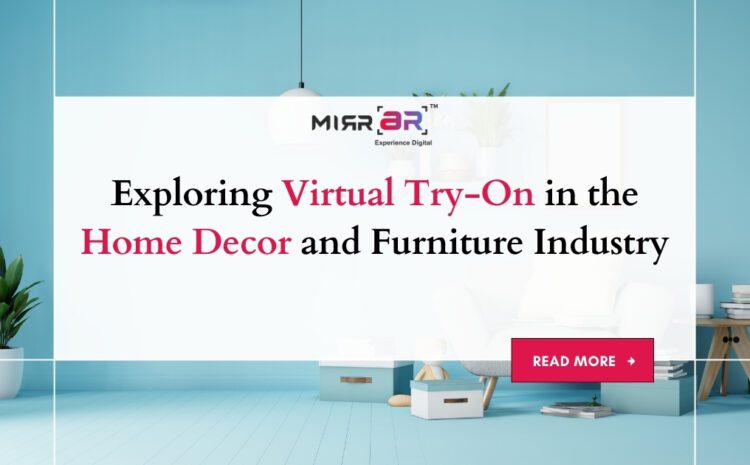In the rapidly evolving world of augmented reality (AR), Virtual Try-On (VTO) has emerged as a revolutionary tool initially designed to transform the fashion and beauty industry. From enabling customers to virtually try on eyeglasses and jewelry to experimenting with lipsticks and outfits, VTO has brought the dressing room to the smartphone. However, its influence is now expanding far beyond apparel. One of the most exciting frontiers for this technology is the home decor and furniture industry, where VTO is redefining how consumers visualize, choose, and purchase products for their personal spaces.
The Shift from Fashion to Furnishing
As e-commerce continues to dominate the retail space, home furnishing brands are increasingly adopting digital-first strategies. But one fundamental challenge remains: consumers find it difficult to visualize furniture and decor in their own environments. Will that couch fit in the living room? Will this lamp match the wall color? These are questions that photos and measurements alone can’t always answer.
Enter Virtual Try-On. Just as consumers can now try on a pair of sunglasses using their smartphone camera, they can place a 3D model of a sofa in their living room using AR. Tools like MirrAR’s VisualizAR and 3D AR Configurator allow users to interact with photorealistic furniture models at scale, exploring materials, colors, and placements—all in real time.
Enhancing Buyer Confidence and Reducing Returns
In furniture retail, product returns can be costly due to size, logistics, and handling. VTO minimizes this problem by letting buyers visualize exactly how products will look and fit in their spaces. This significantly boosts buyer confidence.
For example, a customer shopping for a dining table can place a virtual version in their kitchen and walk around it to check proportions, style match, and alignment with existing décor. This immersive experience reduces the guesswork and ensures more informed decision-making—leading to fewer post-purchase regrets and costly returns.
Virtual Showrooms: A New Dimension in Interior Shopping
The traditional showroom experience has its perks—touching fabrics, seeing scale in person, and comparing materials. But they come with limitations like space constraints and geographic barriers. VTO platforms are solving this by creating virtual showrooms that are accessible 24/7 from anywhere in the world.
With platforms like MirrAR LIVE, brands can host real-time virtual walk-throughs of furnished rooms, allowing users to explore various design combinations and even get guided assistance from sales professionals. This blended experience merges the convenience of online shopping with the personalized service of in-store consultations.
Customization and Personalization
One of the greatest advantages of integrating VTO into the home decor space is the ability to customize products in real-time. Through tools like MirrAR’s 3D AR Configurator, users can change colors, finishes, and layouts on furniture to suit their preferences. Want a velvet green armchair instead of leather? Switch it with a click. Curious about how brass fixtures would look with a certain lighting style? Explore without commitment.
This interactive personalization empowers users and adds a layer of creative involvement in their shopping journey—making it more engaging and emotionally rewarding.
Sustainability and Smart Shopping
By enabling better purchase decisions, VTO is contributing to sustainability in the home furnishing sector. When people can visualize products accurately, they are less likely to overbuy or discard items that don’t fit their expectations. This supports slow shopping—a more conscious and eco-friendly way of purchasing, in contrast to impulse buying and excessive returns.
Additionally, brands can reduce physical inventory and showroom footprints, cutting down on energy consumption and material waste. In the age of climate awareness, this makes VTO not just a smart business move but also a responsible one.
A Competitive Advantage for Retailers
The integration of AR and VTO into home decor offerings is no longer optional—it’s becoming a competitive necessity. Brands that leverage this technology can set themselves apart through immersive shopping experiences, increased customer engagement, and data-backed personalization.
With platforms like MirrAR’s No Code Solution, even small and mid-size retailers can incorporate AR without investing heavily in development. They can deploy interactive VTO features on their websites or apps and reach a broader, tech-savvy audience that craves innovation.
Looking Ahead: What’s Next?
The future of VTO in home decor is teeming with possibilities. As technology matures, we can expect greater realism, haptic feedback, and AI-driven suggestions that enhance the shopping journey further. Imagine a smart assistant that not only shows you how a couch would look in your living room but also recommends throw pillows based on your past purchases and style preferences.
As AR glasses and headsets become more mainstream, customers may soon experience fully immersive home design simulations that are indistinguishable from reality. The boundary between online and offline shopping will continue to blur—and VTO will be the bridge that connects them.
Final Thoughts
Virtual Try-On is no longer just for fashionistas and makeup lovers. It’s carving a dynamic path in industries like home decor and furniture, offering unprecedented levels of interactivity, customization, and convenience. Platforms like MirrAR are at the forefront of this evolution, helping brands and consumers visualize, connect, and co-create beautiful spaces from the comfort of their homes.
In an industry where style and space are deeply personal, VTO ensures every piece fits just right—visually, emotionally, and spatially. It’s not just about trying before buying; it’s about experiencing before owning. And that’s a game-changer for home retail.
